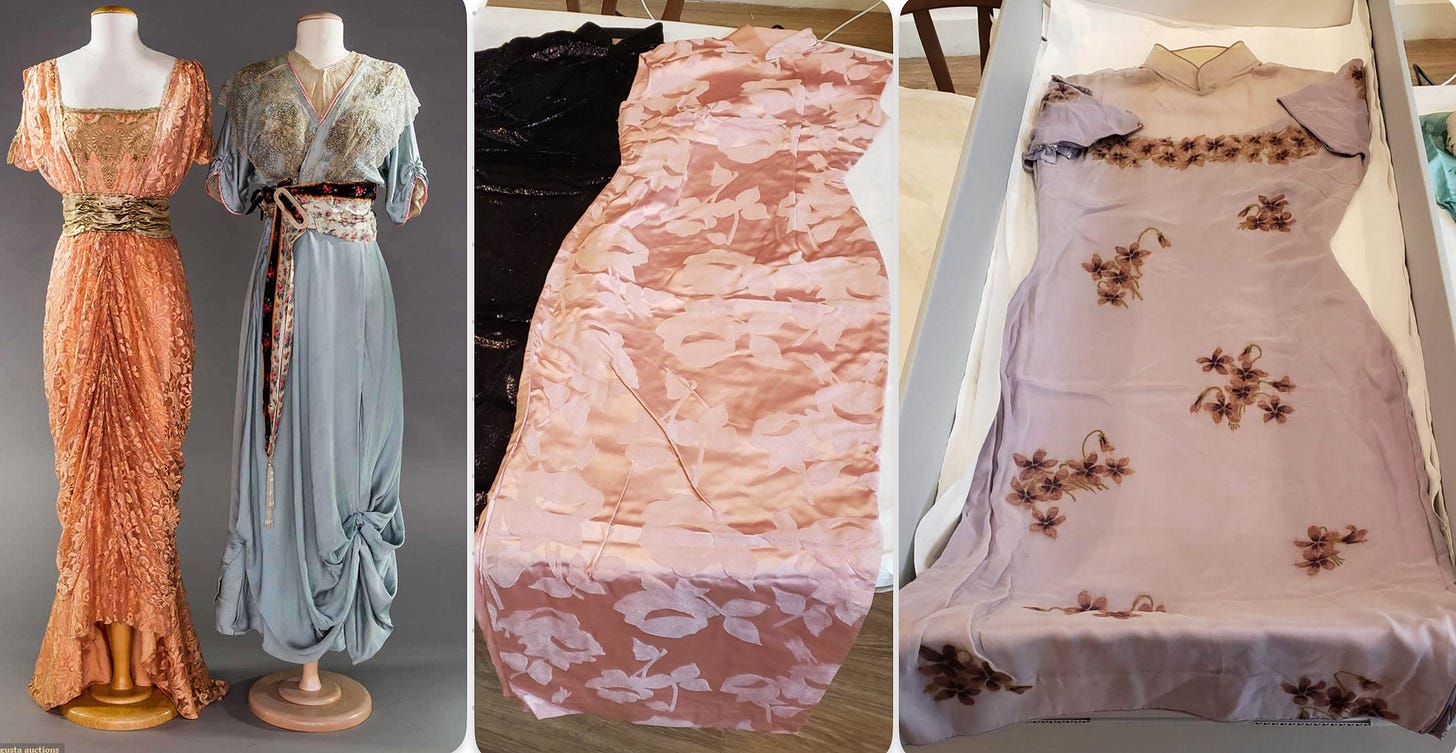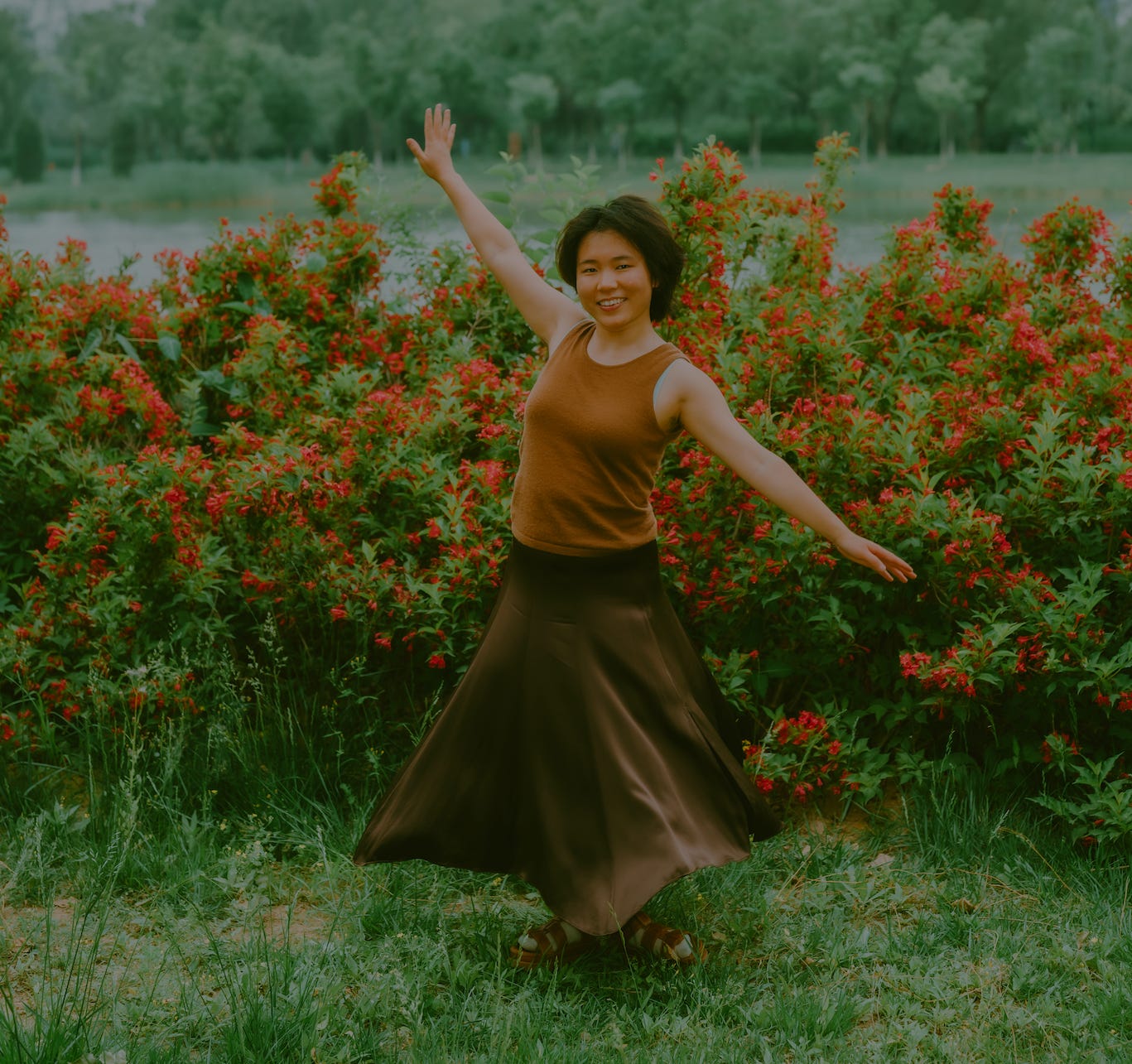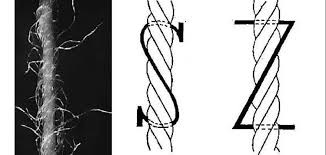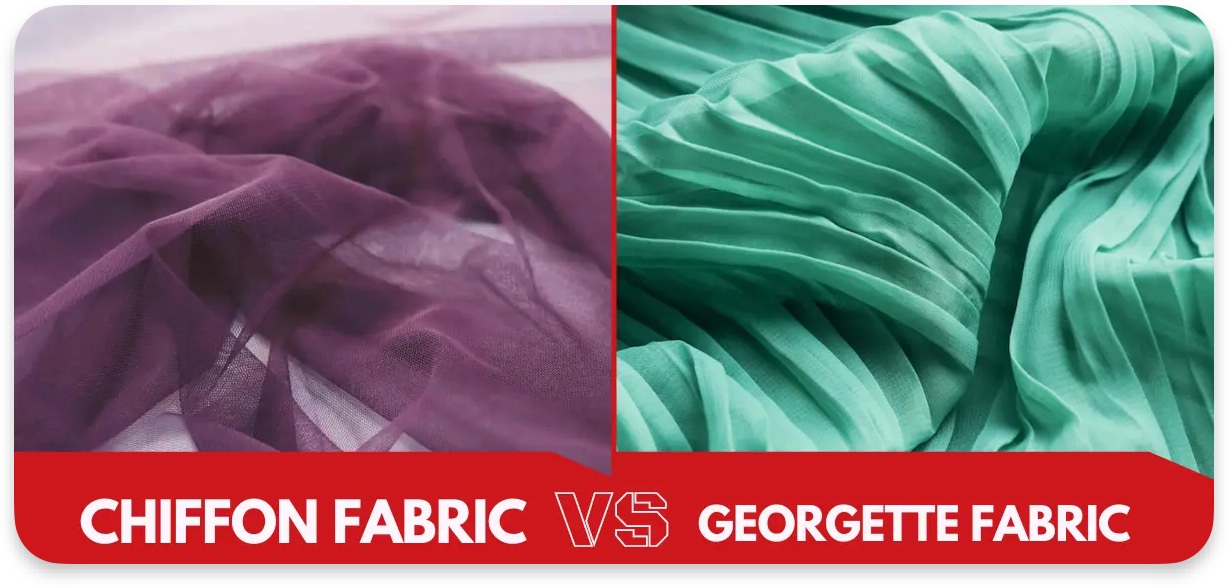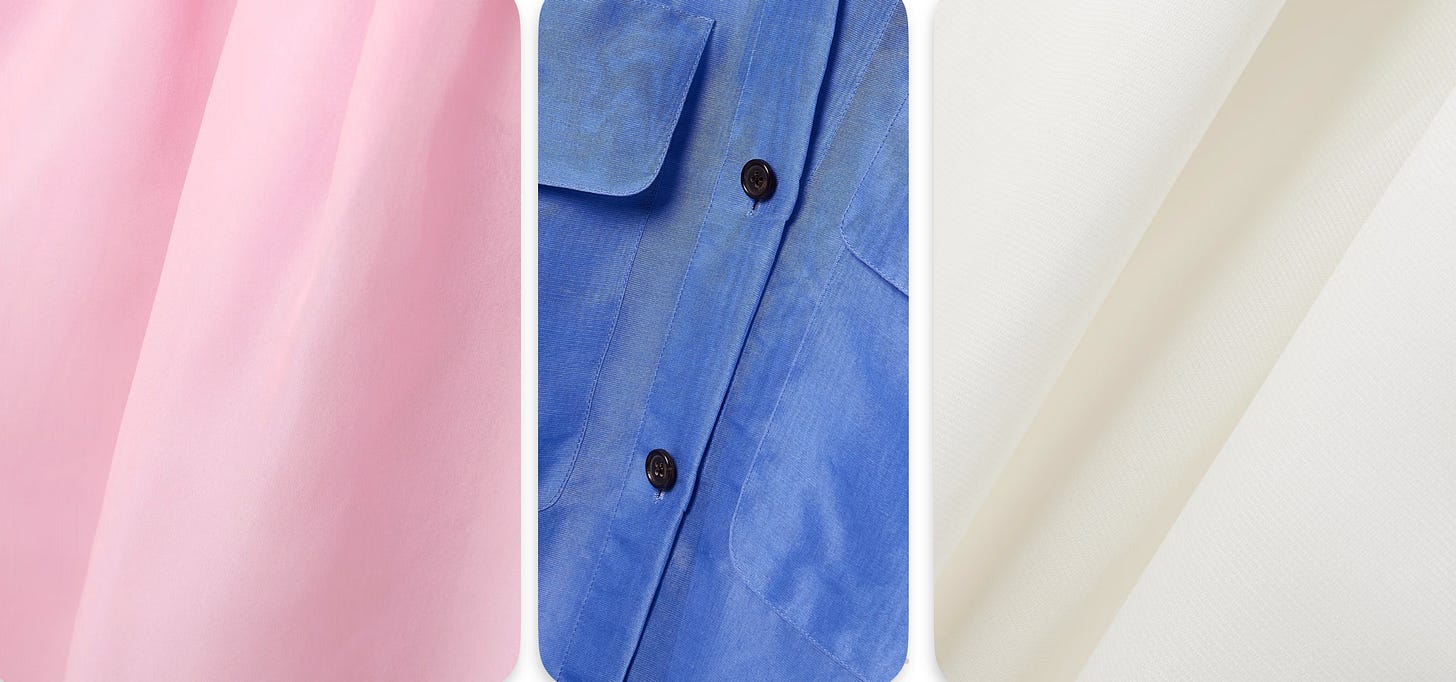Old Money Aesthetic Wardrobe ∥ 6 Essential Silk Fabric Types - Satin, Georgette, Chiffon, Crepon, Organza, Woven & Knitted Categories
When discussing mulberry silk, many people immediately think of traditional Chinese fabric names like "ling luo chou duan" (綾羅綢緞). However, since my research primarily focuses on European and American brands, this article approaches the topic through contemporary fashion brands' most frequently used mulberry silk fabrics. Each weaving technique has corresponding English terminology in modern fabric systems, so I've broadly categorized them as: satin varieties, crepe varieties (including chiffon/georgette and organza), and fabrics that treat mulberry silk like wool or cashmere for worsted weaving and jersey/knit construction.
This article originated from recently viewing garments worn by I.M. Pei's stepmother Aileen Pei at New York's Museum of Chinese in America (MOCA)—predominantly silk-satin and silk-chiffon pieces.
Mulberry silk typically leaves us with initial impressions of two classic fabrics: lustrous satin with its glossy reverse side, and slightly textured crepe varieties like chiffon. In this late 19th-century ensemble on the left, the orange gown features highly lustrous satin, while the blue dress on the right uses chiffon—lighter in weight with softer sheen, where the skirt clearly shows the elasticity and natural drape of pleating.
Aileen Pei's center qipao is also satin, though with floral surface treatment, while the right qipao employs traditional mulberry silk chiffon—breathable and lightweight, with texture between gauze and crepe. The knit texture alone might seem somewhat stifling, but the fabric is actually very lightweight, suitable for summer wear. I remember childhood curtains using similar fabrics in comparable colors, or green with bamboo leaf patterns.
Modern designs influenced by 1990s deconstructivism sometimes combine satin and chiffon in skirt constructions.
China's modern warfare and Cultural Revolution resulted in significant loss of traditional cultural achievements, including the once-diverse array of silk varieties. Consequently, our generation's understanding of silk is often more influenced by Western perspectives, with the most common impressions derived from Western-popularized satin and chiffon, while ancient Chinese silks remain largely confined to period court dramas.
It's important to note that satin, crepe, chiffon, and georgette are essentially different weaving techniques or structural organizations, not fabrics themselves. Therefore, terms like "silk-satin" and "silk-chiffon" mentioned earlier refer to textiles using mulberry silk as the base material. From the mid-to-late 20th century, with mass industrialization and economic development, many traditionally natural materials and weaving processes were gradually replaced by cheaper, easier-care synthetic fibers. Today, minimalist brands like Tove and Toteme in mid-to-lower price ranges, cost-cutting major capital brands, and even entry-level pieces from luxury brands like Khaite often use acetate, polyester, or viscose to replicate these weaves.
Therefore, when shopping, pay special attention to distinguishing between "silk-satin" and "polyester-satin." Even labels marked "silk" may contain only 40%–60% actual mulberry silk, with the remainder being synthetic fiber blends.
Unless otherwise specified with composition details, all fabrics mentioned in this article default to silk fabrics with mulberry silk as the primary material.
01
The 01 category discusses momme silk made from mulberry silk filament, which is the traditional silk we think of - either with brilliant luster, soft and lightweight drape, or thin as cicada wings. Sections 02 and 03 treat mulberry silk like ordinary wool or cashmere for weaving and knitting, discussing thread count rather than momme.
Satin
silk-satin, silk charmeuse
Satin weave techniques first developed in China, characterized by either warp or weft yarns that float for extended periods on the fabric surface in somewhat irregular patterns, but when viewed from a distance create a smooth appearance with mirror-like luster.
Silk-satin techniques spread from Quanzhou, the starting point of the Song Dynasty's maritime Silk Road, to the Middle East around the 12th century, then became popular in Europe, especially Italy. Quanzhou was an important silk trading port during the Song and Yuan periods, described by Marco Polo as "one of the world's two largest trading ports" and "the Alexandria of the East." The word "satin" is said to derive from the Arabic pronunciation of Quanzhou, "Zaitun." Recent years have seen the publication of "Records of Citong's Glory: Quanzhou and the Maritime Silk Road" on this very theme.
For silk-satin, choose 22-25 momme whenever possible (most mid-to-high-end brands use this momme range) for stronger luster and more luxurious appearance. My own mulberry silk satin trousers and half-skirts are all between 22-25 momme, perfect for late spring to early summer weather in May-June.
For high-quality plain satin, choose deep colors like black, burgundy, rosewood, or dark green for that liquid luster flow effect.
The reason is that satin surfaces are highly reflective by nature, and deep colors enhance this luster while containing the reflection, creating sophistication and depth. Light colors tend to appear cheap or "plastic-like," and pale shades expand the reflective area, easily making one look heavy, bloated, or emphasizing unwanted body lines - easily resembling sleepwear.
The left piece is satin with too low momme count, probably under 20 momme, lacking proper satin texture.
If you really want light-colored silk-satin, choose 30+ momme satin, which has a mercury-like flowing texture that uses luxurious feel to offset the color impact. But 30 momme ready-to-wear is virtually unavailable from brands - only select haute couture pieces from individual brands, and these are usually consumed within fashion circles. This momme level silk satin could be used for wedding gowns.
The left two images below show insufficient momme with overly light colors, indeed appearing cheap, while the right two show high-momme texture with stronger, more lustrous pearl-like brilliance.
High-quality fashion brands, knowing they cannot achieve 30 momme but rather standard 22-25 momme, typically offer burgundy, black, and other deep colors. Consider the iconic green dress from the film "Atonement" - the momme count isn't high, but the color adds points.
The two suit sets above are made from Gabriela Hearst's satin weave of 74% organic wool, 26% silk. This brand always innovates with premium fabrics - their silk weaving applications are firsts I've encountered.
Within the silk satin category is silk-charmeuse, which has no direct Chinese translation. I've seen it at high-end brands like GH, Tom Ford, and Khaite. The finished product looks nearly identical to silk satin, but fabric details indicate silk-charmeuse is brighter, lighter, smoother, and more refined.
Indeed, light-colored silk-charmeuse appears more refined, smoother, and lustrous without the cheap appearance of regular light-colored silk-satin.
Below are fabric detail shots of the two pieces above.
Below is a detail shot of regular silk-satin. Comparing the two groups, silk-charmeuse shows more perpendicular, even weave patterns that are flatter, while satin, as I mentioned initially, has floating irregular fibers covering the main warp and weft's perpendicular structure.
China produces plain satin with pearl texture called pearl satin, and jacquard work on satin like traditional qipao called jacquard satin. These lean toward traditional Chinese garments and are rarely seen in Western or modern fashion brands, so I won't elaborate here.
Crepe
silk-chiffon, silk-Georgette, silk-crepon
I used to be puzzled when reading novels about why quality protagonists' clothing descriptions were always either silk satin or silk crepe. After understanding silk satin previously, let me explain silk crepe.
Crepe "绉" doesn't refer to a specific type of weave, but rather an effect that creates a crinkled texture (wrinkled grain) caused by high-twist yarns - a textile texture that feels dry and rough, which can be applied to any fabric.
Common mid-to-low-end minimalist brands like to use acetate for this. Crepe is essentially "crinkle," achieved by adding twist to plain weave fabrics to increase elasticity, pleating, and drape. Therefore, regardless of the fabric type, using the crepe technique creates excellent drape.
The left sample is 83% acetate and 18% viscose fiber, while the right is 64% acetate and 36% mulberry silk. The middle shows a magnified view of the fabric. In the shadowed area of the center slit, you can see the texture has an uneven, somewhat rough surface, similar to the feel of stone-washed material - this is the effect of twist.
Regular wool, viscose, and pure cotton fabrics with Crepe become more smooth and minimalist, like the two images on the left below. The Filippo de Laurentiis Milano Stitch Cotton and Crepe Cotton I wrote about previously are 100% cotton Crepe, which is denser and easier to structure.
Twist means twisting fibers together as shown in the diagram below, generally distinguished between S-twist and Z-twist.
Within the Crepe category, common types include silk-chiffon, silk-Georgette, and silk-crepon. These silk crepe structures all have poor support, with weak stiffness and shape retention. They're too soft and will collapse and lose shape when worn, making them more suitable for feminine, flowing, ethereal fairy-like styles. Men's wear and formal wear don't use these three fabric types.
Chiffon and Georgette are easily confused. Both belong to Plain Weave (the simplest horizontal and vertical crossing pattern), both originated from 19th-20th century France, and both achieve different textures and increased drape through twisting yarns (giving them "crepe" characteristics) and varying arrangement methods.
Chiffon: The word "Chiffon" comes from French, but this lightweight, transparent silk fabric already existed in ancient China, such as various "纱" (sha) and "罗" (luo). Modern silk chiffon became popular in 19th century Europe, particularly France, with the development of the silk industry. Initially made entirely from real silk, it was expensive and a luxury item for nobility and upper society. In the early 20th century, with the emergence of synthetic fibers (like nylon and polyester), chiffon became more accessible.
Georgette: Georgette is named after the famous French women's fashion designer Georgette de la Plante from the early 20th century. Inspired by Chiffon, she wanted to create a fabric that had chiffon's lightness and flow but was more durable and textured than chiffon. Therefore, Georgette uses stronger twist and tighter arrangement, giving it a unique crepe effect and slightly rough hand feel. It was also originally made from real silk.
Although Chiffon is mostly thin, it can occasionally be thick; although Georgette tends to be thick and dense, it can occasionally be thin. Therefore, don't distinguish them by weight alone - you must look at the texture and grain.
In the two groups of semi-transparent tops below, the left is Georgette and the right is chiffon. As mentioned in the previous chiffon qipao discussion, chiffon texture gives a more muffled feeling, while Georgette's sandy stone texture is more obvious.
Common Silk-Chiffon includes the two semi-transparent styles on the left and the yellow one on the right that's woven more densely.
The mulberry silk lining we purchased uses Chiffon, generally as lining. The two Chiffon linings on the right side of the photo have more sandy texture and look muffled.
The outer layer of this garment uses mulberry silk spun like wool or cashmere, which might be spun silk made from scraps. This type can't be measured in momme - it should be counted by yarn count like wool and cashmere.
For different thicknesses and transparencies of Silk-Chiffon, I judge by whether the texture has that muffled feeling. 8-momme or 10-momme chiffon is semi-transparent, which I don't particularly like as it has a common, cheap feeling. Because of the low momme count, it's cheaper than satin and Georgette, no wonder brands like Elie Saab and Gabriela Hearst (shown in the left two images) use it for Printed Silk.
Actually, traditional chiffon is 8mm, 10mm transparent gauze (English: voile or gauze), while 16-momme chiffon is rare. Only in recent years has this technique been used to make high-momme, less transparent garments. The red shirt in the middle is probably 19-momme.
Georgette's texture has more obvious irregular sandy grain feeling, rougher and drier, easily wrinkled. Georgette skirt hems easily develop lettuce edges, so many designers deliberately design with these decorative lettuce edge details.
In recent years, high-momme Georgette pleated evening dresses have been favored by major brands. Elie Saab (left two pieces), Valentino (purple), and Gabriela Hearst (white) all make them.
The left image shows lower momme count (estimated 10mm) Georgette, more transparent, where you can clearly see the fabric's rough sandy texture. The right side has higher momme count and is more refined, but you can still see Georgette's sandy texture upon close inspection.
The left image shows silk-Georgette fabric detail. In the right dress, the shoulder joint area has rough, sandy-textured Georgette, while the lower arm and main body fabric is smooth with the muffled feeling of silk-chiffon, and the belt is silk-charmeuse.
Chloé frequently uses silk-Georgette, but they can't distinguish between chiffon and Georgette, labeling many chiffons as Georgette. This might be because chiffon generally refers to transparent gauze, so changing it to Georgette seems more appropriate. But looking closely at Chloé's gauze, it has that muffled feeling - I think it's just high-momme chiffon.
These two are easily confused. What I remember now is: Chiffon traditionally refers to 6mm-10mm transparent gauze with muffled texture, but in recent years, non-transparent high-momme versions have been made, though many brands label them as Georgette. Georgette's core characteristic is texture like irregular stones, with rough and sandy feeling. High-momme Georgette's stronger drape easily forms lettuce edges. If you really can't distinguish between them, call the transparent ones silk-voile or silk-gauze, and the less transparent ones silk-crepe.
Now let's discuss the third type of Crepe, which is silk-crepon with shallow plissé-like texture. Below is the silk-crepon fabric detail.
The garment corresponding to the above detail image. Chloé makes the most of these lightweight, soft, girlish silk-crepon and silk-Georgette styles.
Organza
After getting through the most difficult-to-distinguish silk crepe category, Organza is much easier to differentiate. Although organza is semi-transparent like traditional Chiffon, both having 8mm and 10mm momme counts, organza fabric is obviously stiffer with many three-dimensional straight lines. It lacks the drape that chiffon crepe's twist brings, doesn't conform to body shape, especially evident in the third blue organza shirt shown below.
The representative brand for organza is Khaite Dress. Khaite's style tends toward sharp, three-dimensional, straight lines - completely opposite to Chloé's flowing softness above.
You can see above that Khaite organza likes to create varying transparencies. They weave organza using twill methods similar to poplin, making it thicker and more durable, as shown in the white fabric detail on the far right, corresponding to the white dress above.
I think the blue one might be made from tussah silk, which is wild silk. This silk is relatively hard, dry, and has structure. The base fabric for gambiered Canton gauze is generally tussah silk. Unlike the mulberry silk above, gambiered Canton gauze isn't measured in momme but emphasizes dyeing techniques. Currently, European and American brands haven't ventured into this area - only Chinese brands occasionally use it, so I won't elaborate here. The texture is similar to organza's cool, somewhat hard sandpaper feel.
I'll write a dedicated piece about tussah silk later. Currently, tussah silk, like hemp, has started becoming popular in China in recent years, while Europe and America haven't much explored it yet.
02
This section introduces mulberry silk used in industrial textile manufacturing, which is actually more common in European and American brands than the 01 section, especially among Italian brands. The mulberry silk socks from 4 top Italian men's hosiery brands I wrote about previously was my first encounter with this textile-use mulberry silk. I don't care whether it's spun silk made from scraps - as long as it's mulberry silk from reliable brands, it's fine.
Because this is most common, English labels simply say "silk" without adding specific mulberry silk process names like Organza, Voile, Chiffon, etc. All major suit brands, quiet luxury brands, and cashmere brands use this textile process for mulberry silk - spinning mulberry silk the same way as wool and cashmere.
The final garment style resembles wool and cashmere but retains mulberry silk's own lustrous, smooth, and delicate fabric characteristics.
My own 8 spring-summer wool and mulberry silk trousers use mulberry silk like shown in the model images above - either silk-satin or regular silk weaving.
The blue pair uses industrial worsted spinning, while the right side is approximately 16-momme silk-satin. Comparing the two, the industrial worsted mulberry silk trousers are more refined and heavier-weight, comparable to 26mm high-momme silk satin.
Industrial textile silk has a softer luster compared to silk satin. These two types of mulberry silk fabrics are the most common and basic in daily life. The three major Crepe categories and organza from section 01 are too girlish and formal-dress oriented.
To make mulberry silk more structured and shaped, the weave is changed to Twill diagonal patterns.
Currently, even top brands like Gabriela Hearst, Tom Ford, and Kiton typically blend their mulberry silk suits with half proportions of wool, cashmere, or linen fabrics. I haven't seen pure mulberry silk suits yet, but pure tussah silk can achieve this since it's harder in texture. However, it's not currently popular since tussah silk isn't as refined as mulberry silk.
Although I mentioned in Kiton men's and women's casual pants in 4 core fits that men generally wear linen for summer while women wear mulberry silk, and many images in the 10 special linen processes, 5 hemp type differences linen article feature various menswear, when you encounter the opportunity, still try it - mulberry silk is simply better than linen fabric. This year Eddy started with the first silk weave mulberry silk long pants and several pairs of 100% mulberry silk socks - very refined, smooth, and cool.
Let's look at other mulberry silk industrial weave processes. The left image shows soft Jersey, a technique beloved for pure cotton T-shirts - James Perse was mentioned before. The right side resembles large-gauge cashmere knit.
There are also some innovative specialty mulberry silk fabrics. Both of these are from Gabriela Hearst, who loves innovating high-end fabrics. The left is silk-boucle blended with mulberry silk and camel hair. Boucle is actually cashmere loop yarn - I summarized common cashmere knitting techniques in Lisa Yang. The right is silk-velvet, pure mulberry silk velvet. I previously organized her main specialty fabrics in Gabriela Hearst 7 types of skirts and 12 specialty fabrics.
Epilogue
In summary, my favorites are silk-satin and textile knit mulberry silk. These materials are more suitable for daily wear, lean toward basics, and offer high practicality. In contrast, I don't particularly like chiffon and organza that are too thin and transparent - they have limited wearing scenarios and aren't practical enough. Thicker versions of Georgette made into dresses, while I haven't encountered suitable ones yet, I would still consider purchasing if I found nice styles.
In early summer, heavy-weight woven mulberry silk long pants are suitable; by midsummer, I recommend lighter 16-momme plain satin, worsted, or Jersey knit mulberry silk, paired with mulberry silk sleeveless tops and shorts for a fresh and comfortable look. Those early summer long pants need to be stored away in February and worn again when autumn arrives in September.
pamperherself






